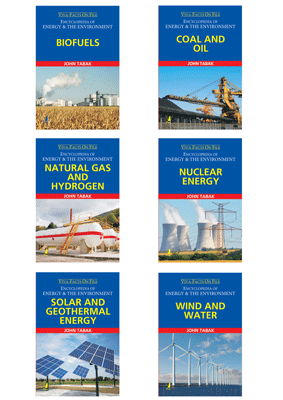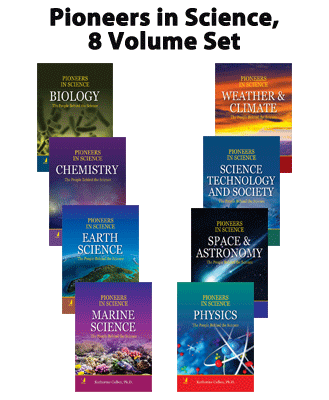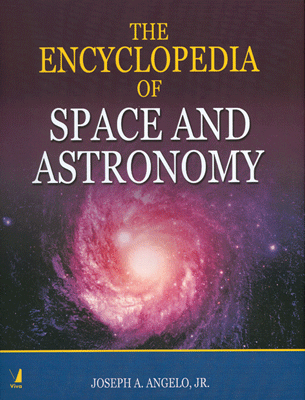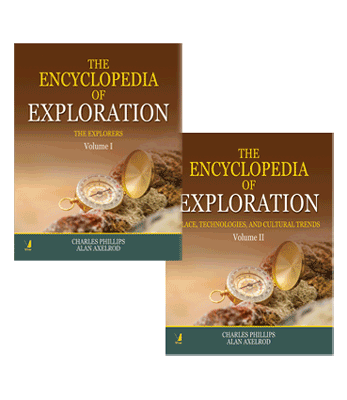
Encyclopedia of Energy and the Environment, 6 Vol Set
Encyclopedia of Energy and the Environment, 6 Vol Set
₹12,595.50 ₹13,995.00 Save: ₹1,399.50 (10%)
Go to cartISBN: 9788130915654
Bind: Hardbound
Year: 2014
Pages: 1732
Size: . mm
Publisher: Facts On File Inc.
Published in India by: Viva Books
Exclusive Distributors: Viva Books
Sales Territory: India, Nepal, Pakistan, Bangladesh, Sri Lanka
Descripttion:
Energy and the Environment is a six-volume set that examines the history, technology, science, and environmental and social implications (including issues of Environmental justice) associated with the acquisition and production of energy. Designed to complement science curricula, each volume describes comprehensively one or more sources of energy and the technology needed to make it useful. The books emphasize the science on which such technology is based, the limitations of each technology, the environmental effects of its use, questions of availability and cost, and the way that government policies and energy markets interact.
Each Volume contains more than 40 color photographs and four-color line illustrations, sidebars, a chronology, a list of acronyms, a glossary, a detailed list of print and Internet resources, and an index. Energy and the Environment is essential for high school students, teachers, and general readers who wish to learn about the effects on society of large-scale energy production and consumption.
Volume 1: Biofuels
Biofuels describes the principal fuels derived from recently decayed biological material, the methods by which they are produced, and their uses in transportation and in electricity production. The book also discusses the implications of large-scale biofuel use on the environment and on the economy, with special consideration given to its effects on the price of food. The book features an exclusive interview with economist Dr. Amani Elobeid, a widely respected expert on ethanol, food security, trade policy, and the international sugar markets, who shares her thoughts on these subjects.
The volume includes information on
- biodiesel
- biomass
- combustion
- electricity production
- environmental protection
- ethanol
- the nature and history of biofuels
- policy, research, and legislation
Contents:
Preface • Acknowledgments • Introduction • Part I The Nature and History of Biofuels • First Fuels • What Are Biofuels” • A Brief History of Fire and Wood • Early Conservation Efforts • Ancient Forests, Modern Humans • The Nature of Fuel • The Energy Content of Biofuels • Availability and Cost • Sinks, Sources, and the Greenhouse Effect • Big and Small Environmental and Economic Effects • The Chemistry of Combustion • Theoretical Combustion • Combustion: Some Practical Concerns • Efficient Engines • Sustainability • Part II Some Important Biofuel Technologies • Ethanol • The Mechanics of Ethanol Production • Ethanol in Brazil • The Net Energy Balance • The United States Ethanol Market • Biodiesel • Some Properties of Biodiesel • The Biodiesel Market: Demand and Supply • Biodiesel from Algae • Electricity Production • Electricity Production and the Electricity Markets • Biofuel-Fired Power Plants • A Case Study: Power Generation versus the Environment • Part III Environmental and Policy Considerations • Large-Scale Use of Biomass • Biomass as a Form of Solar Energy • How Much Land for How Much Fuel” • Siting Biorefineries • Alternative Reasons for the Consumption of Biofuels • A Form of Environmental Protection • The Pulp and Paper Industry • Gasification Technology in the Pulp and Paper Industry • Fire Suppression • Policy, Research, and Biofuels • Overcoming Inertia • Switchgrass: a Future Fuel • Legislating a Market for Ethanol • Science, Commerce, and Biofuels • Conclusion • Afterword: An Interview with Dr. Amani Elobeid on the Economics of Ethanol
Volume 2: Coal and Oil
Coal and Oil is a timely overview of the complex relationship that the world has with these primary sources of fuels. The book describes the characteristics of these energy sources, the ways in which they are used, and the technical, social, policy, and environmental consequences of large scale coal and oil consumption. The book also features an exclusive interview with Ms. Charlene Marshall, a member of the West Virginia house of Delegates, who shares her thoughts on the safety and environmental hazards of coal and coal mining.
The volume includes information on
- alternative uses for coal and oil
- the chemistry and geology of oil
- the environmental and social costs of mining
- the global oil economy's impact on the environment
- a historical overview of the coal and oil industries
- obtaining and transporting oil
- oil markets and governmental policies
- power-production technologies
Contents:
Preface • Acknowledgments • Introduction • Part 1 Coal • A Brief History of Coal • The Early History of Coal • The Coal Industry in the United States • Life and Death in Early Coal Mines • Geochemistry and Geology • The Chemistry of Coal • A Coal Economy • The Geology of Coal • Meeting the Demand for Coal • The Scale of Demand • Environmental and Social Costs of Mining • An Interview with Charlene Marshall on the Human Costs of Coal • The Combustion Reaction • Products and Reactants • Global Warming and Carbon Sequestration • The Role of the Oceans • Electricity Production and Its Consequences • New Power-Production Technologies • More on CO2 Sequestration • Emissions Controls • Alternative Uses for Coal • Methane from Coal • Coal as a Transportation Fuel • A Source for Hydrogen Gas • Engineering the Climate • Price versus Cost and National Coal Policies • Pricing Coal • National Energy Policies • Carbon Trading Markets • Part 2 Oil • A Brief History of Oil • The Oil Business Prior to 1950 • Standard Oil • The Oil Business after 1950 • The Geology and Chemistry of Oil • Oil and Geology • The Chemistry of Oil • When Will the World Run Out of Oil” • Meeting the Demand for Oil • Obtaining Oil • The Oil Sands of Alberta • Transporting Oil • Creating and Consuming Petroleum Products • Refineries • The Chemistry of Combustion • The Refinery Business • Patterns of Consumption • The Transportation Sector • Alternatives to Gasoline • Other Uses of Oil • Environmental Costs of the Oil Economy • Local Effects • Global Effects • The Arctic National Wildlife Refuge • Oil Markets and Government Policies • Pricing Petroleum • Collusion or Free Market” • National Policies • Chronology • List of Acronyms • Glossary • Further Resources • Index
Volume 3: Natural Gas and Hydrogen
Natural Gas and Hydrogen is a timely overview of the complex relationship that the world has with two significant sources of gaseous fuel. The book discusses the business of natural gas production and the energy futures markets that have evolved as vehicles for speculation and risk management. It also focuses on the possible advantages of adopting hydrogen as a viable source of energy, as well as on the inevitable obstacles that hamper large-scale fuel switching. The author includes an exclusive interview with Dr. ray Boswell of the U.S. Department of Energy's National Energy Technology Laboratory in which Boswell discusses his work in identifying and characterizing methane hydrate reservers, one of the most promising fields of energy research today.
The volume includes information on
- early gas technologies and policies
- electricity generation
- energy markets and energy politics
- government policies
- a hydrogen economy
- the origin and nature of natural gas
- the physical and chemical properties of hydrogen
- the restructured natural gas market
Contents:
Preface • Acknowledgments • Introduction • Part 1 Natural Gas • Early Gas Technologies and Policies • Coal Gas • The End of Coal Gas • Early Attempts to Use Natural Gas • Early Attempts at Regulation • The Nature of Natural Gas • The Origin of Natural Gas • Synthetic Gas • Carbon Dioxide Sequestration • Transporting and Storing Natural Gas • Gas Pipelines • The Energy Content of Natural Gas • Liquefied Natural Gas • Natural Gas Storage • Electricity Generation • The Production of Heat • Energy Conversion • Alternatives to Natural Gas • Effects on the Environment • The Restructured Natural Gas Market • Pipelines: A Natural Monopoly • The Changing Nature of Natural Gas • Natural Gas Storage: No Longer a Monopoly • Energy Markets and Energy Politics • Prices and Profits in the Natural Gas Industry • Energy Policies and Their Effects • An Interview with Ray Boswell about Methane Hydrate Research • Part 2 Hydrogen • The Physical and Chemical Properties of Hydrogen • Hydrogen Production • Onboard Hydrogen Storage • Energy Conversion • Hydrogen Safety • The Hydrogen Economy • The Transition to a Hydrogen Economy • How Long until the Hydrogen Economy” • Characteristics of the Hydrogen Economy • Government Policies • Politics versus Physics • The Hydrogen Marketplace Today • Current Hydrogen Research • Chronology • List of Acronyms • Glossary • Further Resources • Index
Volume 4: Nuclear Energy
Nuclear Energy is an objective discussion of commercial nuclear power, a hotly debated issue of worldwide significance for many decades and one of the most controversial power-generation technologies. The book covers not only the physics and technology of energy production, reactor design, and nuclear safety but also the relationship between commercial nuclear power and nuclear proliferation and the United States attempts to resolve the problem of nuclear waste disposal. The book also features an exclusive interview with Harold Denton, the former director of the Office of Nuclear Reactor Regulation at the U.S. Nuclear Regulatory Commission, on the commercial nuclear industry.
The volume includes information on
- the business of electricity production
- nuclear energy and national policy
- reactor fuel
- nuclear reactor designs
- the physics of nuclear fission
- a prehistory of nuclear power
- reactor safety
- spent fuel
Contents:
Preface • Acknowledgments • Introduction • A Prehistory of Nuclear Power • The First Heat Engines • Carnot and the Efficiency of Heat Engines • Radioactive Materials as Sources of Thermal Energy • Global Warming and Nuclear Power • The Physics of Nuclear Fission • Atomic Particles • Conservation Laws and Radioactive Processes • Atomic Fission • Fermi's Reactor • Reactor Fuel • Manufacturing Reactor Fuel • Inside the Reactor • Nuclear Weapon Proliferation • The International Atomic Energy Agency • Nuclear Reactor Designs • Boiling Water Reactors • Pressurized Water Reactors • The Accident at Chernobyl • CANDU Reactors • Future Reactor Designs • Reactor Safety • Radiation Effects • Independent Redundant Subsystems • Where Are the Fatalities” • Event Trees • Spent Fuel • The Composition and Characteristics of Spent Fuel • Managing Spent Fuel • Building for Eternity • Is Yucca Mountain Safe Enough” • Nonscientific Objections to the Yucca Mountain Site • The Business of Electricity Production • Utilities as Natural Monopolies • ISO New England • The Nature of Supply and Demand • Nuclear Power in the United States Today • Nuclear Energy and National Policy • Some Arguments for Nuclear Power • Some Arguments against Nuclear Power • Nuclear Power Policy in Germany • Nuclear Power Policy in the United States • Nuclear Power Policy in France • Conclusion • Afterword: An Interview with Harold Denton: On the U.S. Nuclear Power Industry
Volume 5: Solar and Geothermal Energy
Solar and Geothermal Energy describes two of the least environmentally disruptive sources of power by which electricity is generated today. In addition to an overview of both solar and geothermal energy and the processes by which they can be harnessed, the book details how these sources are used to supply electricity and discusses ways in which governmental policies affect the growth of these sectors of the power market. The book also features an exclusive interview with John Farison, director of process engineering for Calpine Corporation at the Geysers Geothermal Field, one of the world's largest and most productive geothermal facilities, in which he discusses the challenges of maintaining output at the facility.
- alternative geothermal technologies
- economic and environmental consequences and energy
- geology and heat
- heat engines and solar power
- photovoltaics
- sunlight and geometry
- government policies and energy
- solar power and geothermal energy use through history
Contents:
Preface • Acknowledgments • Introduction • Part I Solar Energy • A Brief History of Solar Power • Sunlight and Heat • The Photophone: A Solar-Powered Telephone • Early Photovoltaic Technology • Sunlight and Geometry • The Electromagnetic Spectrum • Geometry and Sunlight • Space-Based Solar Power • Photovoltaics • Light versus Electricity • Technical Considerations • Photons and Electricity • Net Metering • Heat Engines and Solar Power • Converting Thermal Energy into Electrical Energy • Advantages and Disadvantages of CSP Technology • Storing Solar Energy • Two Other Important Solar Technologies • Solar Water Heaters • Demand Management • Greener Architecture • Economic and Environmental Consequences of Solar Power • Matching Solar Supply with Consumer Demand • Connecting Electricity Producers with Consumers: A Case Study • Available Energy • Government Policies and Solar Energy • Solar Energy Policy in the United States • Distributed Generation • Solar Energy in Germany • Part II Geothermal Energy • A Brief History of Geothermal Energy • Heat, Geology, and the Age of Earth • Magma Chambers • Location of Geothermal Sites • Early Geothermal Technology • Geology and Heat • Mining Thermal Energy • Fenton Hill, New Mexico: The First Enhanced Geothermal System • Heat Engines • The Generating Station • Technical Considerations • An Interview with John Farison on the Challenges of Producing Power at the Geysers • Coproduction of Geothermal Energy • Two Other Geothermal Technologies • Direct-Piped Hot Water • Geothermal Heat Pumps • The Economics and Environmental Impacts of Electricity from Geothermal Sources • Economic Costs and the Problem of Scale • Global Warming and Geothermal Power • Geothermal Energy and the Environment • Government Policies and Geothermal Energy • The International Energy Agency • The Cost of Energy • Geothermal Power Production Today • Chronology • List of Acronyms • Glossary • Further Resources • Index
Volume 6: Wind and Water
Wind and Water describes conventional hydropower, or wind power, and some newer technologies (with less predictable futures) that are being introduced to harness the power of ocean currents, ocean waves, and the temperature difference between the upper and lower layers of the ocean. The book discusses the strengths and limitations of each technology, the mathematical models that articulate the maximum amount of energy that can be channeled through such devices, how these power producers benefit from government subsidies, and the economics of operating these types of generating stations. The book includes an exclusive interview with Dr. Stan Bull, associate director for science and technology at the National Renewable Energy Laboratory, in which he shares views on how scientific research projects should be managed and evaluated.
The volume includes information on
- costs and public policy considerations
- “creating” supply and demand
- history of waterpower and wind power
- government's role in promoting new technologies
- hydroelectric power
- heat engines
- tidal and wave power
- wind energy
Contents:
Preface • Acknowledgments • Introduction • Part I Hydroelectric Power • Waterpower: A Brief History • Designs from Antiquity • The Industrial Revolution and Michael Faraday • Creating Electricity Demand and Supply • Niagara Falls • Theory and Practice • Turbine Design • The Water Supply • Pumped Storage • Base Load versus Peak Load • Costs and Policies • The Costs of Hydropower • Global Warming • More about Environmental Costs • Methane Emissions and Hydropower • The Future of Hydropower • Part II Electricity from the Oceans • Wave Power • Sea Snakes • Blow Holes • The Archimedes Wave Swing • Tidal Power • The French and Canadian Projects • Turbines without Dams • Heat Engines • The Theory of Heat Engines • Practical Applications • Ocean Thermal Energy Conversion Tests • The Role of Government in Promoting New Technologies • The United States: Creating Supply and Demand • An Interview with Dr. Stan Bull on Research at the NREL • Denmark: Creating Supply, Demand, and Goodwill • Germany: Rapid Growth, Ambitious Goals • Part III Wind Power • Wind Power: A Brief History • Windmills • Wind Turbines • The Altamont Pass Wind Resource Area • The Nature of Wind Power • How Much Energy Is in the Wind” • Estimating Capacity • Storing the Wind • Wind Power, Topography, and the Environment • Wind Energy: Economic and Public Policy Considerations • The Costs of Wind Power • The Role of Economic Class • The Future of Wind Power
About the Author:
John Tabak, Ph.D., performed graduate work at the State University of New York at Stony Brook and received a degree in mathematics from Rensselaer Polytechnic Institute. He is the author of The History of Mathematics, a multivolume reference set, and Significant Gestures: A History of American Sign Language, a social and scientific history of one of North America's most unique languages.






